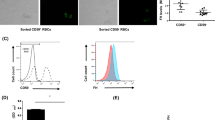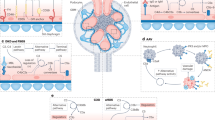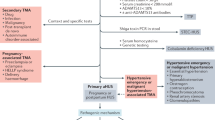Abstract
The complement system provides critical immunoprotective and immunoregulatory functions but uncontrolled complement activation can lead to severe pathology. In the rare hemolytic disease paroxysmal nocturnal hemoglobinuria (PNH), somatic mutations result in a deficiency of glycosylphosphatidylinositol-linked surface proteins, including the terminal complement inhibitor CD59, on hematopoietic stem cells. In a dysfunctional bone marrow background, these mutated progenitor blood cells expand and populate the periphery. Deficiency of CD59 on PNH red blood cells results in chronic complement-mediated intravascular hemolysis, a process central to the morbidity and mortality of PNH. A recently developed, humanized monoclonal antibody directed against complement component C5, eculizumab (Soliris; Alexion Pharmaceuticals Inc., Cheshire, CT, USA), blocks the proinflammatory and cytolytic effects of terminal complement activation. The recent approval of eculizumab as a first-in-class complement inhibitor for the treatment of PNH validates the concept of complement inhibition as an effective therapy and provides rationale for investigation of other indications in which complement plays a role.
This is a preview of subscription content, access via your institution
Access options
Subscribe to this journal
Receive 12 print issues and online access
$209.00 per year
only $17.42 per issue
Buy this article
- Purchase on SpringerLink
- Instant access to full article PDF
Prices may be subject to local taxes which are calculated during checkout





Similar content being viewed by others
Change history
12 December 2007
In the version of this article initially published, on p.1258, 2nd paragraph, the incorrect eculizumab serum concentrations appear to reach steady state and the incorrect accumulation ratio (Racc) for eculizumab were given. The correct sentence is “Eculizumab serum concentrations appear to reach steady state after ~57 days. At steady state, the eculizumab accumulation ratio (Racc) was calculated to be 1.075.” In addition, in Figure 5, in the PDF version only, the word “assessment” was cut off the bottom of the box beginning “September 2006”. The final sentence should read “BLA and MAA submitted to FDA and EMEA, respectively; receive accelerated assessment.” And in Table 1, the heading “Units of packed RBCs transfused/patient/month” now appears in a separate row. The errors have been corrected in the HTML and PDF versions of the article.
References
Matis, L.A. & Rollins, S.A. Complement-specific antibodies: designing novel anti-inflammatories. Nat. Med. 1, 839–842 (1995).
Walport, M.J. Complement. Second of two parts. N. Engl. J. Med. 344, 1140–1144 (2001).
Male, D., Brostoff, J., Roth, D. & Roitt, I. Immunology (Mosby-Elsevier, Philadelphia, 2006).
Abdul Ajees, A. et al. The structure of complement C3b provides insights into complement activation and regulation. Nature 444, 221–225 (2006).
Janssen, B.J. et al. Structures of complement component C3 provide insights into the function and evolution of immunity. Nature 437, 505–511 (2005).
Janssen, B.J., Christodoulidou, A., McCarthy, A., Lambris, J.D. & Gros, P. Structure of C3b reveals conformational changes that underlie complement activity. Nature 444, 213–216 (2006).
Wiesmann, C. et al. Structure of C3b in complex with CRIg gives insights into regulation of complement activation. Nature 444, 217–220 (2006).
Overturf, G.D. Indications for the immunological evaluation of patients with meningitis. Clin. Infect. Dis. 36, 189–194 (2003).
Huber-Lang, M. et al. Generation of C5a in the absence of C3: a new complement activation pathway. Nat. Med. 12, 682–687 (2006).
Muller-Eberhard, H.J. Molecular organization and function of the complement system. Annu. Rev. Biochem. 57, 321–347 (1988).
Rabiet, M.J., Huet, E. & Boulay, F. The N-formyl peptide receptors and the anaphylatoxin C5a receptors: an overview. Biochimie 89, 1089–1106 (2007).
Chen, N.J. et al. C5L2 is critical for the biological activities of the anaphylatoxins C5a and C3a. Nature 446, 203–207 (2007).
Yamashina, M. et al. Inherited complete deficiency of 20-kilodalton homologous restriction factor (CD59) as a cause of paroxysmal nocturnal hemoglobinuria. N. Engl. J. Med. 323, 1184–1189 (1990).
Motoyama, N., Okada, N., Yamashina, M. & Okada, H. Paroxysmal nocturnal hemoglobinuria due to hereditary nucleotide deletion in the HRF20 (CD59) gene. Eur. J. Immunol. 22, 2669–2673 (1992).
Platonov, A.E., Vershinina, I.V., Kuijper, E.J., Borrow, R. & Kayhty, H. Long term effects of vaccination of patients deficient in a late complement component with a tetravalent meningococcal polysaccharide vaccine. Vaccine 21, 4437–4447 (2003).
Thomas, T.C. et al. Inhibition of complement activity by humanized anti-C5 antibody and single-chain Fv. Mol. Immunol. 33, 1389–1401 (1996).
Riechmann, L., Clark, M., Waldmann, H. & Winter, G. Reshaping human antibodies for therapy. Nature 332, 323–327 (1988).
Weng, N.P., Yu-Lee, L.Y., Sanz, I., Patten, B.M. & Marcus, D.M. Structure and specificities of anti-ganglioside autoantibodies associated with motor neuropathies. J. Immunol. 149, 2518–2529 (1992).
Klein, R., Jaenichen, R. & Zachau, H.G. Expressed human immunoglobulin kappa genes and their hypermutation. Eur. J. Immunol. 23, 3248–3262 (1993).
Mueller, J.P. et al. Humanized porcine VCAM-specific monoclonal antibodies with chimeric IgG2/G4 constant regions block human leukocyte binding to porcine endothelial cells. Mol. Immunol. 34, 441–452 (1997).
Canfield, S.M. & Morrison, S.L. The binding affinity of human IgG for its high affinity Fc receptor is determined by multiple amino acids in the CH2 domain and is modulated by the hinge region. J. Exp. Med. 173, 1483–1491 (1991).
Burton, D.R. & Woof, J.M. Human antibody effector function. Adv. Immunol. 51, 1–84 (1992).
Tao, M.H., Smith, R.I. & Morrison, S.L. Structural features of human immunoglobulin G that determine isotype-specific differences in complement activation. J. Exp. Med. 178, 661–667 (1993).
Smith, R.I., Coloma, M.J. & Morrison, S.L. Addition of a mu-tailpiece to IgG results in polymeric antibodies with enhanced effector functions including complement-mediated cytolysis by IgG4. J. Immunol. 154, 2226–2236 (1995).
Hill, A. et al. Sustained response and long-term safety of eculizumab in paroxysmal nocturnal hemoglobinuria. Blood 106, 2559–2565 (2005).
Wang, Y., Rollins, S.A., Madri, J.A. & Matis, L.A. Anti-C5 monoclonal antibody therapy prevents collagen-induced arthritis and ameliorates established disease. Proc. Natl. Acad. Sci. USA 92, 8955–8959 (1995).
Wang,Y. et al. Amelioration of lupus-like autoimmune disease in NZB/WF1 mice after treatment with a blocking monoclonal antibody specific for complement component C5. Proc. Natl. Acad. Sci. USA 93, 8563–8568 (1996).
Jain, R.I., Moreland, L.W., Caldwell, J.R., Rollins, S.A. & Mojcik, C.F. A single dose, placebo controlled, double blind, phase I study of the humanized anti-C5 antibody h5G1.1 in patients with rheumatoid arthritis. Arthritis Rheum. 42, S77 (1999).
Rother, R.P., Mojcik, C.F. & McCroskery, E.W. Inhibition of terminal complement: a novel therapeutic approach for the treatment of systemic lupus erythematosus. Lupus 13, 328–334 (2004).
Verrier, E.D. et al. Terminal complement blockade with pexelizumab during coronary artery bypass graft surgery requiring cardiopulmonary bypass: a randomized trial. J. Am. Med. Assoc. 291, 2319–2327 (2004).
Armstrong, P.W. et al. Pexelizumab for acute ST-elevation myocardial infarction in patients undergoing primary percutaneous coronary intervention: a randomized controlled trial. J. Am. Med. Assoc. 297, 43–51 (2007).
Tesser, J. et al. Safety and efficacy of the humanized anti-C5 antibody h5G1.1 in patients with rheumatoid arthritis. Arthritis Rheum. 44, S274 (2001).
Appel, G. et al. Eculizumab (C5 complement inhibitor) in the treatment of idiopathic membranous nephropathy (IMN): Preliminary baseline and pharmacokinetic (PK) /Pharmacodynamic (PD) Data. J. Am. Soc. Nephrol. 13, 668a (2002).
Hill, A. et al. The incidence and prevalence of paroxysmal nocturnal hemoglobinuria (PNH) and survival of patients in Yorkshire. Blood 108, 985 (2006).
Parker, C. et al. Diagnosis and management of paroxysmal nocturnal hemoglobinuria. Blood 106, 3699–3709 (2005).
Takeda, J. et al. Deficiency of the GPI anchor caused by a somatic mutation of the PIG-A gene in paroxysmal nocturnal hemoglobinuria. Cell 73, 703–711 (1993).
Bessler, M. et al. Paroxysmal nocturnal haemoglobinuria (PNH) is caused by somatic mutations in the PIG-A gene. EMBO J. 13, 110–117 (1994).
Oni, S.B., Osunkoya, B.O. & Luzzatto, L. Paroxysmal nocturnal hemoglobinuria: evidence for monoclonal origin of abnormal red cells. Blood 36, 145–152 (1970).
Hu, R. et al. PIG-A mutations in normal hematopoiesis. Blood 105, 3848–3854 (2005).
Araten, D.J., Nafa, K., Pakdeesuwan, K. & Luzzatto, L. Clonal populations of hematopoietic cells with paroxysmal nocturnal hemoglobinuria genotype and phenotype are present in normal individuals. Proc. Natl. Acad. Sci. USA 96, 5209–5214 (1999).
Dacie, J. [Paroxysmal nocturnal haemoglobinuria.] Sangre (Barc.) 25, 890–895 (1980).
Rotoli, B. & Luzzatto, L. Paroxysmal nocturnal hemoglobinuria. Semin. Hematol. 26, 201–207 (1989).
Rawstron, A.C. et al. The PNH phenotype cells that emerge in most patients after CAMPATH-1H therapy are present prior to treatment. Br. J. Haematol. 107, 148–153 (1999).
Hansch, G.M., Schonermark, S. & Roelcke, D. Paroxysmal nocturnal hemoglobinuria type III. Lack of an erythrocyte membrane protein restricting the lysis by C5b-9. J. Clin. Invest. 80, 7–12 (1987).
Okada, N., Harada, R. & Okada, H. Erythrocytes of patients with paroxysmal nocturnal hemoglobinuria acquire resistance to complement attack by purified 20-kD homologous restriction factor. Clin. Exp. Immunol. 80, 109–113 (1990).
Holguin, M.H., Fredrick, L.R., Bernshaw, N.J., Wilcox, L.A. & Parker, C.J. Isolation and characterization of a membrane protein from normal human erythrocytes that inhibits reactive lysis of the erythrocytes of paroxysmal nocturnal hemoglobinuria. J. Clin. Invest. 84, 7–17 (1989).
Rollins, S.A. & Sims, P.J. The complement-inhibitory activity of CD59 resides in its capacity to block incorporation of C9 into membrane C5b-9. J. Immunol. 144, 3478–3483 (1990).
Rosenfeld, S.I., Jenkins, D.E. Jr, & Leddy, J.P. Enhanced reactive lysis of paroxysmal nocturnal hemoglobinuria erythrocytes. Studies on C9 binding and incorporation into high molecular weight complexes. J. Exp. Med. 164, 981–997 (1986).
Brodsky, R.A. Paroxysmal nocturnal hemoglobinuria. in Hematology: Basic Principles and Practice (eds. Hoffman, R. & Benz E. J. Jr. et al.) 419–427 (Churchill Livingstone, Philadelphia, 2005).
Bottomley, A. et al. Health-related quality of life in survivors of locally advanced breast cancer: an international randomised controlled phase III trial. Lancet Oncol. 6, 287–294 (2005).
Cella, D., Lai, J.S., Chang, C.H., Peterman, A. & Slavin, M. Fatigue in cancer patients compared with fatigue in the general United States population. Cancer 94, 528–538 (2002).
Wisloff, F., Gulbrandsen, N., Hjorth, M., Lenhoff, S. & Fayers, P. Quality of life may be affected more by disease parameters and response to therapy than by haemoglobin changes. Eur. J. Haematol. 75, 293–298 (2005).
Rother, R.P., Bell, L., Hillmen, P. & Gladwin, M.T. The clinical sequelae of intravascular hemolysis and extracellular plasma hemoglobin: a novel mechanism of human disease. J. Am. Med. Assoc. Review article correlating intravascular hemolysis and cell-free plasma hemoglobin to the clinical sequelae of PNH and other hemolytic diseases 293, 1653–1662 (2005).
Hill, A., Rother, R.P. & Hillmen, P. Improvement in the symptoms of smooth muscle dystonia during eculizumab therapy in paroxysmal nocturnal hemoglobinuria. Haematologica 90, ECR40 (2005).
Gralnick, H.R. et al. Activated platelets in paroxysmal nocturnal haemoglobinuria. Br. J. Haematol. 91, 697–702 (1995).
Audebert, H.J., Planck, J., Eisenburg, M., Schrezenmeier, H. & Haberl, R.L. Cerebral ischemic infarction in paroxysmal nocturnal hemoglobinuria report of 2 cases and updated review of 7 previously published patients. J. Neurol. 252, 1379–1386 (2005).
Hall, C., Richards, S. & Hillmen, P. Primary prophylaxis with warfarin prevents thrombosis in paroxysmal nocturnal hemoglobinuria (PNH). Blood 102, 3587–3591 (2003).
Olsen, S.B. et al. Enhancement of platelet deposition by cross-linked hemoglobin in a rat carotid endarterectomy model. Circulation 93, 327–332 (1996).
Radomski, M.W., Palmer, R.M. & Moncada, S. Endogenous nitric oxide inhibits human platelet adhesion to vascular endothelium. Lancet 2, 1057–1058 (1987).
Radomski, M.W., Palmer, R.M. & Moncada, S. The anti-aggregating properties of vascular endothelium: interactions between prostacyclin and nitric oxide. Br. J. Pharmacol. 92, 639–646 (1987).
Shao, J. et al. Protective role of nitric oxide in a model of thrombotic microangiopathy in rats. J. Am. Soc. Nephrol. 12, 2088–2097 (2001).
Catani, M.V., Bernassola, F., Rossi, A. & Melino, G. Inhibition of clotting factor XIII activity by nitric oxide. Biochem. Biophys. Res. Commun. 249, 275–278 (1998).
Kayanoki, Y. et al. Reduced nitric oxide production by L-arginine deficiency in lysinuric protein intolerance exacerbates intravascular coagulation. Metabolism 48, 1136–1140 (1999).
Hillmen, P., Lewis, S.M., Bessler, M., Luzzatto, L. & Dacie, J.V. Natural history of paroxysmal nocturnal hemoglobinuria. N. Engl. J. Med. 333, 1253–1258 (1995).
Socie, G. et al. Paroxysmal nocturnal haemoglobinuria: long-term follow-up and prognostic factors. French Society of Haematology. Lancet 348, 573–577 (1996).
Moyo, V.M., Mukhina, G.L., Garrett, E.S. & Brodsky, R.A. Natural history of paroxysmal nocturnal haemoglobinuria using modern diagnostic assays. Br. J. Haematol. 126, 133–138 (2004).
Araten, D.J., Thaler, H.T. & Luzzatto, L. High incidence of thrombosis in African-American and Latin-American patients with paroxysmal nocturnal haemoglobinuria. Thromb. Haemost. 93, 88–91 (2005).
Nishimura, J. et al. Clinical course and flow cytometric analysis of paroxysmal nocturnal hemoglobinuria in the United States and Japan. Medicine (Baltimore) 83, 193–207 (2004).
Hill, A. et al. High definition contrast-enhanced MR imaging in paroxysmal nocturnal hemoglobinuria (PNH) suggests a high frequency of subclinical thrombosis. Blood 108, 979 (2006).
Rother, R.P. et al. Expression of recombinant transmembrane CD59 in paroxysmal nocturnal hemoglobinuria B cells confers resistance to human complement. Blood 84, 2604–2611 (1994).
Nishimura, J. et al. Efficient retrovirus-mediated PIG-A gene transfer and stable restoration of GPI-anchored protein expression in cells with PNH phenotype. Blood 97, 3004–3010 (2001).
Yonemura, Y. et al. Paroxysmal nocturnal haemoglobinuria with coexisting deficiency of the ninth component of complement: lack of massive haemolytic attack. Br. J. Haematol. 74, 108–113 (1990).
Hillmen, P. et al. Effect of eculizumab on hemolysis and transfusion requirements in patients with paroxysmal nocturnal hemoglobinuria. N. Engl. J. Med. 350, 552–559 (2004).
Hillmen, P. et al. The complement inhibitor eculizumab in paroxysmal nocturnal hemoglobinuria. N. Engl. J. Med. 355, 1233–1243 (2006).
Schrezenmeier, H. et al. Safety and efficacy of the terminal complement inhibitor eculizumab in patients with paroxysmal nocturnal hemoglobinuria: SHEPHERD phase III clinical study results. Haematologica 92, 1696 (2007).
Muus, P. et al. The clinical benefit of eculizumab is demonstrable in all subpopulations of patients with paroxysmal nocturnal hemoglobinuria (PNH) with hemolysis. Haematologica 92, 379 (2007).
Hillmen, P. et al. Effect of the complement inhibitor eculizumab on thromboembolism in patients with paroxysmal nocturnal hemoglobinuria. Blood, published online 16 August 2007 (doi 10.1182/blood-2007-1106-095646).
Wang, H. et al. Prevention of acute vascular rejection by a functionally blocking anti-C5 monoclonal antibody combined with cyclosporine. Transplantation 79, 1121–1127 (2005).
Biesecker, G. & Gomez, C.M. Inhibition of acute passive transfer experimental autoimmune myasthenia gravis with Fab antibody to complement C6. J. Immunol. 142, 2654–2659 (1989).
Christadoss, P. C5 gene influences the development of murine myasthenia gravis. J. Immunol. 140, 2589–2592 (1988).
Morgan, B.P. et al. The membrane attack pathway of complement drives pathology in passively induced experimental autoimmune myasthenia gravis in mice. Clin. Exp. Immunol. 146, 294–302 (2006).
Sawant-Mane, S., Clark, M.B. & Koski, C.L. In vitro demyelination by serum antibody from patients with Guillain-Barre syndrome requires terminal complement complexes. Ann. Neurol. 29, 397–404 (1991).
Willison, H.J. Basic and clinical aspects of autoimmune disorders in peripheral nerves. Acta Neurol. Scand. Suppl. 183, 14–18 (2006).
Girardi, G. et al. Complement C5a receptors and neutrophils mediate fetal injury in the antiphospholipid syndrome. J. Clin. Invest. 112, 1644–1654 (2003).
Ritis, K. et al. A novel C5a receptor-tissue factor cross-talk in neutrophils links innate immunity to coagulation pathways. J. Immunol. 177, 4794–4802 (2006).
Keegan, M. et al. Relation between humoral pathological changes in multiple sclerosis and response to therapeutic plasma exchange. Lancet 366, 579–582 (2005).
Peng, T. et al. Role of C5 in the development of airway inflammation, airway hyperresponsiveness, and ongoing airway response. J. Clin. Invest. 115, 1590–1600 (2005).
Nozaki, M. et al. Drusen complement components C3a and C5a promote choroidal neovascularization. Proc. Natl. Acad. Sci. USA 103, 2328–2333 (2006).
Acknowledgements
The authors wish to acknowledge the Alexion research team for their involvement in the identification and characterization of eculizumab, the Alexion clinical and drug development teams for the eculizumab clinical program, the clinicians and patients for their participation in the trials, and Kerry Quinn-Senger and Rebecca Baker for assistance with the preparation of this manuscript.
Author information
Authors and Affiliations
Corresponding author
Ethics declarations
Competing interests
R.P.R., S.A.R. and L.B. are employees of Alexion Pharmaceuticals, Inc. and have equity ownership in the company. They have assigned to Alexion Pharmaceuticals their inventions made as employees and have received no royalties from the company for these inventions. C.F.M. is a former employee of Alexion and is a consultant for the company. R.A.B. is a consultant for Alexion and has received lecture fees from the company.
Rights and permissions
About this article
Cite this article
Rother, R., Rollins, S., Mojcik, C. et al. Discovery and development of the complement inhibitor eculizumab for the treatment of paroxysmal nocturnal hemoglobinuria. Nat Biotechnol 25, 1256–1264 (2007). https://doi.org/10.1038/nbt1344
Published:
Issue Date:
DOI: https://doi.org/10.1038/nbt1344



